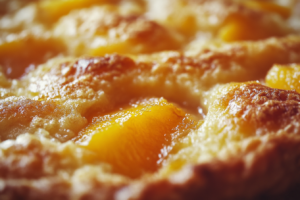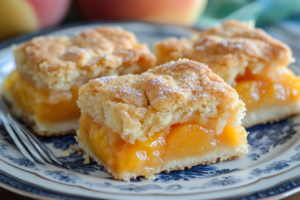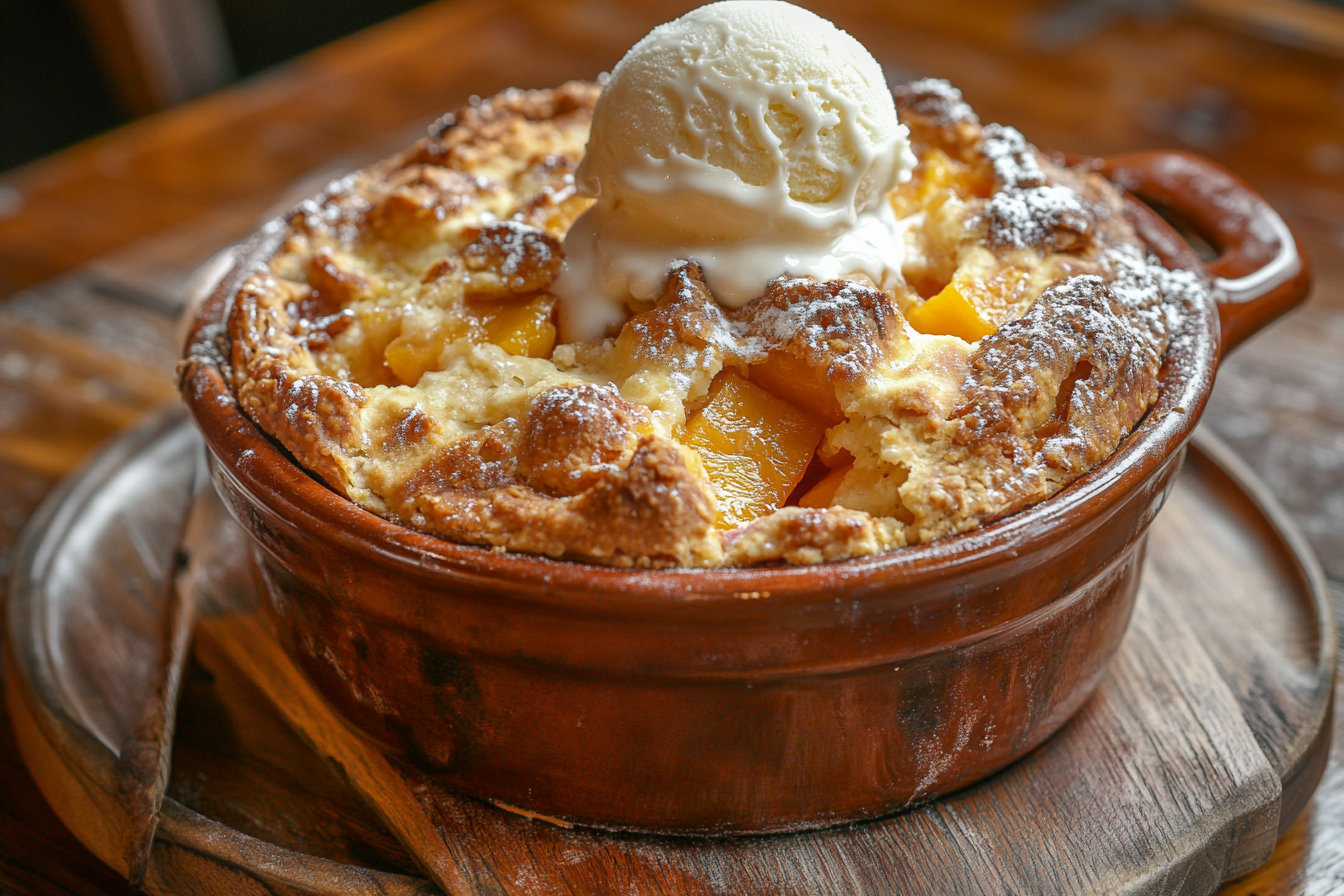Peach cobbler is a classic dessert cherished for its combination of sweet, tender peaches and a flavorful crust. But what makes peach cobbler crust so special, and how can you create the perfect one? From traditional recipes that stick to the basics to modern twists with unique ingredients, the crust plays a pivotal role in this dish’s deliciousness. Whether you’re new to baking or a seasoned expert, this guide will provide you with everything you need to know about mastering the art of cobbler crust.
Introduction to Peach Cobbler

What Is Peach Cobbler?
Peach cobbler is a timeless dessert that layers juicy, baked peaches under a rich, golden crust. Unlike pies, cobblers are known for having a single top crust, which gives them their signature rustic look and feel. This dessert’s simplicity makes it both comforting and versatile, with endless possibilities for customization.
Why the Crust Matters
The crust is the heart of a peach cobbler. It adds texture, flavor, and balance to the dessert. A good crust enhances the natural sweetness of the peaches while providing a satisfying crunch or fluffiness, depending on the style of the topping.
Traditional vs. Modern Peach Cobbler Crust
Traditionally, cobbler crusts relied on pantry staples like flour, sugar, and butter to create a simple yet delightful topping. Over time, recipes have evolved to include creative variations, from gluten-free flours to vegan alternatives, making it possible for everyone to enjoy this comforting dessert.
The Blend of Tradition and Innovation
While traditional cobbler crusts are loved for their nostalgia, modern versions have added new dimensions to this classic treat. Whether you prefer a flaky, buttery crust or a soft, biscuit-like topping, there’s a perfect recipe waiting to be discovered.
Understanding the Components of a Cobbler Crust
The Role of the Crust in Peach Cobbler
A cobbler’s crust is a defining element, offering a delightful contrast to the warm and juicy peach filling. Unlike pie crusts, which are often delicate and thin, cobbler crusts have a more rustic, comforting appeal, made to soak up the sweet juices while maintaining their own texture.
Key Ingredients for a Delicious Crust

The basic components of any cobbler crust are simple and versatile. Each plays a unique role in creating the perfect balance of flavor and texture:
- Flour: Provides the structure of the crust. While all-purpose flour is commonly used, whole wheat or gluten-free options are great for customization.
- Sugar: Sweetens the crust and helps it develop a golden-brown finish during baking. Brown sugar or alternative sweeteners can add a rich flavor twist.
- Fat: Butter is the classic choice for its richness and flakiness, but shortening or margarine can create a slightly different texture.
- Liquid: Commonly water, milk, or buttermilk, which binds the ingredients. Buttermilk adds tanginess for an extra flavor dimension.
- Leavening Agents: Baking powder or baking soda is essential for making the crust light and fluffy, giving it a biscuit-like texture.
Exploring Ingredient Variations
What makes cobbler crusts so versatile is how easily they can adapt to individual tastes or dietary needs:
- For Gluten-Free Baking: Almond flour, coconut flour, or gluten-free flour blends work as excellent substitutes for traditional flour.
- Vegan-Friendly Alternatives: Butter can be swapped for coconut oil or vegan margarine, and dairy milk can be replaced with almond, soy, or oat milk.
- Flavor Twists: Incorporating spices like cinnamon, nutmeg, or ginger can enhance the flavor. For a more unique approach, zest from lemons or oranges can add a citrusy kick.
A Canvas for Creativity
The crust of a cobbler isn’t just a topping—it’s a creative element that allows bakers to experiment with flavors, textures, and dietary preferences. Whether sticking to the basics or venturing into innovative territory, the crust offers endless opportunities to elevate your peach cobbler.
Types of Peach Cobbler Crusts

Biscuit-Style Crust
Many bakers love the biscuit-style crust for its rustic charm and hearty texture. This topping is thick, slightly crumbly, and perfectly absorbs the peach juices while holding its shape. To create this type of crust, you mix simple ingredients like flour, sugar, butter, milk, and baking powder until just combined. Then, you spoon or drop the dough over the peach filling. This method creates a warm, homey appearance that’s perfect for traditional Southern-style baking.
Pie-Style Crust
The pie-style crust provides a more elegant presentation while still being easy to prepare. Bakers typically use classic ingredients, such as flour, cold butter, a pinch of salt, and ice water, to create this flaky topping. After chilling the dough to ensure tenderness, you roll it out thinly and drape it over the peach filling. This type of crust suits those who want the sophistication of a pie with the comforting simplicity of a cobbler.
Cake-Like Crust
For a softer, spongier topping, the cake-like crust stands out as a delightful choice. Unlike biscuit or pie-style options, this crust uses a batter made from flour, sugar, eggs, butter, and baking powder. When poured over the peaches, the batter spreads evenly as it bakes, forming a golden layer with a slightly crisp surface. Many people enjoy this variation for its resemblance to a dessert cake filled with juicy peaches.
Pre-Made Crusts
If you’re in a hurry, pre-made crusts offer a convenient alternative. These store-bought options come ready to roll out or cut to fit your cobbler dish. While they might lack the charm of homemade dough, they still deliver reliable results for busy bakers who don’t want to compromise on taste.
Choosing the Right Crust
The perfect cobbler crust depends on your taste and the occasion. If you prefer a hearty and rustic topping, go for a biscuit crust. For a more elegant look, choose a pie crust. Meanwhile, the cake-like crust is ideal if you want a soft and spongy option. Regardless of your choice, each type of crust brings its unique qualities to the dish, making every peach cobbler special.
Step-by-Step Guide to Making Peach Cobbler Crust
Essential Tools for Success
Before diving into the recipe, gather the tools you’ll need for a smooth baking process. These include:
- Mixing Bowls: For combining dry and wet ingredients.
- Pastry Cutter or Fork: To blend the fat into the flour efficiently.
- Rolling Pin: Useful for pie-style crusts.
- Baking Dish: A deep dish that can hold the juicy peach filling and the crust.
Having these tools ready ensures that the process flows smoothly without interruptions.
Basic Recipe for Cobbler Crust
Creating a perfect cobbler crust doesn’t require advanced skills. By following this simple recipe, you can achieve a delightful balance of flavors and textures.
Ingredients:
- 2 cups of all-purpose flour
- ½ cup of granulated sugar
- 1 teaspoon of baking powder
- 1 pinch of salt
- 1 cup of cold butter (cut into small cubes)
- ½ cup of cold milk or buttermilk
Instructions:
- Combine Dry Ingredients: In a large mixing bowl, whisk together the flour, sugar, baking powder, and salt.
- Add Butter: Using a pastry cutter or fork, cut the cold butter into the dry ingredients until the mixture resembles coarse crumbs.
- Incorporate Liquid: Gradually pour in the milk, stirring gently until a dough forms. Avoid overmixing to keep the crust tender.
- Prepare the Dough: Roll out the dough on a floured surface for a pie-style crust or drop spoonfuls over the filling for a biscuit-style crust.
- Assemble and Bake: Place the crust over the peach filling and bake at 375°F (190°C) until the top turns golden brown.
Common Mistakes to Avoid
Even the most straightforward recipe can go awry if you’re not mindful of certain pitfalls:
- Overmixing the Dough: This can lead to a dense, tough crust. Mix only until the ingredients come together.
- Skipping the Butter Chilling Step: Warm butter can ruin the texture, so ensure it stays cold until combined with the flour.
- Uneven Crust Thickness: Keep the crust evenly rolled or spooned to ensure uniform baking.
Tips for Perfecting the Crust
Mastering cobbler crust requires some finesse, but these tips will help you get it right every time:
- Adjust for Weather: On humid days, the dough might need a bit more flour to prevent stickiness.
- Flavor Boosts: Add a teaspoon of cinnamon or a splash of vanilla extract to the dough for an extra layer of flavor.
- Test for Doneness: Use a toothpick to check the crust in multiple spots. It should come out clean but not dry.
With these steps and tips, you’ll create a peach cobbler crust that’s as memorable as the dessert itself.
Enhancing Your Peach Cobbler Crust
Adding Unique Flavors
A peach cobbler crust is versatile, and incorporating additional flavors can elevate your dessert from delicious to unforgettable. Here are some ways to boost the flavor of your crust:
- Spices: Add a pinch of cinnamon, nutmeg, or ginger to the dry ingredients. These warm spices complement the natural sweetness of peaches beautifully.
- Citrus Zest: Grate lemon or orange zest into the dough for a refreshing and tangy twist.
- Sweet Enhancements: Sprinkle coarse sugar or brown sugar on top of the crust before baking to create a caramelized finish.
Improving Texture
A perfect cobbler crust balances crispness and tenderness, and there are a few tricks to achieve this harmony:
- Egg Wash: Brushing the crust with an egg wash (a mixture of beaten egg and water or milk) before baking creates a glossy, golden surface.
- Coarse Sugar Topping: Sprinkling raw sugar over the egg wash adds crunch and a delightful visual appeal.
- Incorporating Oats or Nuts: Mix a handful of rolled oats or finely chopped nuts into the dough for an added layer of texture.
Creative Twists
Sometimes, stepping away from tradition can lead to an exciting and memorable dessert. Consider these innovative ideas for your next peach cobbler:
- Nutty Crust: Add ground almonds or pecans to the flour for a nutty, flavorful base.
- Alternative Flours: Experiment with almond flour, coconut flour, or whole wheat flour to create unique textures and flavors.
- Savory Spin: For an unexpected twist, reduce the sugar and add a pinch of rosemary or thyme to the dough, giving the crust a subtle, herbaceous note.
Practical Baking Tips
- Even Cooking: Rotate your baking dish halfway through the cooking time to ensure the crust bakes evenly.
- Sealing the Edges: If you’re using a pie-style crust, crimp the edges to prevent the filling from bubbling over.
- Letting It Rest: Allow the cobbler to rest for 10–15 minutes after baking to let the crust set properly and the filling thicken.
By enhancing your peach cobbler crust with these flavorful and practical ideas, you’ll transform this traditional dessert into a culinary masterpiece.
Frequently Asked Questions (FAQs)
What makes a peach cobbler crust different from a pie crust?
A peach cobbler crust differs from a pie crust primarily in texture and preparation. While pie crusts are rolled thin and typically used to encase the filling, cobbler crusts are thicker and placed on top of the fruit. They can range from biscuit-like to cake-like, offering a more rustic and casual vibe compared to the flaky elegance of a pie crust.
Can I make peach cobbler crust gluten-free?
Absolutely! To make a gluten-free cobbler crust, you can substitute all-purpose flour with gluten-free blends available at most grocery stores. Almond flour, coconut flour, or a combination of gluten-free flours also works well. Just remember to adjust the liquid content slightly since alternative flours absorb moisture differently.
What is the best fat to use in cobbler crust?
The choice of fat greatly influences the crust’s flavor and texture. Butter is often preferred for its rich taste and flaky results, but shortening or margarine can also be used. For a vegan option, coconut oil or plant-based butter works wonderfully.
Can I use frozen peaches for peach cobbler?
Yes, frozen peaches are an excellent alternative when fresh peaches are out of season. Thaw and drain them before use to prevent excess moisture from making the cobbler soggy. You might also need to adjust the sugar in the recipe since frozen peaches can sometimes be sweeter than fresh ones.
How do I prevent my crust from becoming soggy?
To keep your crust from becoming soggy, ensure the peaches are well-drained if they’re canned or frozen. You can also coat the fruit in a bit of cornstarch or flour before adding the crust to help absorb extra juices. Baking the cobbler on the lower rack of your oven ensures the crust gets enough heat to cook through properly.
By addressing these common questions, you’ll have all the tips and tricks needed to create a peach cobbler with a crust that’s nothing short of perfect.
Conclusion
Recap of Key Points
Peach cobbler is more than just a dessert; it’s a celebration of flavors, textures, and traditions. Central to its appeal is the crust, which ties everything together by providing the perfect balance to the juicy peach filling. Throughout this article, we’ve explored what goes into making a great cobbler crust, from the basic ingredients to creative variations like gluten-free and vegan options. We’ve also looked at different styles of crusts—biscuit, pie-style, and cake-like—each bringing its unique flair to the dish.
Encouragement to Experiment
While the traditional cobbler crust holds a special place in many kitchens, there’s no harm in stepping outside the box. Adding spices, nuts, or alternative flours can elevate your cobbler to new heights, making it uniquely yours. Whether you’re a fan of the rustic charm of a biscuit crust or prefer the delicate flakiness of a pie-style topping, there’s always room for creativity in the kitchen.
Call to Action
So, what are you waiting for? Grab some fresh peaches, gather your favorite crust ingredients, and start baking your perfect peach cobbler today. With these tips and insights, you’re well-equipped to create a dessert that’s not only delicious but also a true reflection of your personal style. Happy baking!

